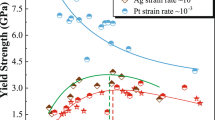Abstract
The plastic deformation and the ultrahigh strength of metals at the nanoscale have been predicted to be controlled by surface dislocation nucleation. In situ quantitative tensile tests on individual 〈111〉 single crystalline ultrathin gold nanowires have been performed and significant load drops observed in stress-strain curves suggest the occurrence of such dislocation nucleation. High-resolution transmission electron microscopy (HRTEM) imaging and molecular dynamics simulations demonstrated that plastic deformation was indeed initiated and dominated by surface dislocation nucleation, mediating ultrahigh yield and fracture strength in sub-10-nm gold nanowires.

Similar content being viewed by others
References
Greer, J. R.; Nix, W. D. Nanoscale gold pillars strengthened through dislocation starvation. Phys. Rev. B 2006, 73, 245410.
Uchic, M. D.; Dimiduk, M. D.; Florando, J. N.; Nix, W. D. Sample dimensions influence strength and crystal plasticity. Science 2004, 305, 986–989.
Shan, Z. W.; Mishra, R. K.; Asif, S. A. S.; Warren, O. L.; Minor, A. M. Mechanical annealing and source-limited deformation in submicrometre-diameter Ni crystals. Nat. Mater. 2008, 7, 115–119.
Rabkin, E.; Srolovitz, D. J. Onset of plasticity in gold nanopillar compression. Nano Lett. 2007, 7, 101–107.
Zhu, T.; Li, J.; Samanta, A.; Leach, A.; Gall, K. Temperature and strain rate dependence of surface dislocation nucleation. Phys. Rev. Lett. 2008, 100, 025502.
Cimalla, V.; Röhlig, C. C.; Pezoldt, J.; Niebelschütz, M.; Ambacher, O.; Brückner, K.; Hein, M.; Weber, J.; Milenkovic, S.; Smith, A. J.; Hassel, A. W. Nanomechanics of single crystalline tungsten nanowires. J. Nanomater. 2008, 2008, 638947.
Wu, B.; Heidelberg, A.; Boland, J. J. Mechanical properties of ultrahigh-strength gold nanowires. Nat. Mater. 2005, 4, 525–529.
Wang, M. S.; Kaplan-Ashiri, I.; Wei, X.; Rosentsveig, R.; Wagner, H.; Tenne, R.; Peng, L. In situ TEM measurements of the mechanical properties and behavior of WS2 nanotubes. Nano Res. 2008, 1, 22–31.
Hsin, C. L.; Mai, W. J.; Gu, Y. D.; Gao, Y. F.; Huang, C. T.; Liu, Y. Z.; Chen, L. J.; Wang, Z. L. Elastic properties and buckling of silicon nanowires. Adv. Mater. 2008, 20, 3919–3923.
Zhu, Y.; Moldovan, N.; Espinosa, H. D. A microelectro-mechanical load sensor for in situ electron and X-ray microscopy tensile testing of nanostructures. Appl. Phys. Lett. 2005, 86, 013506.
Zhu, Y.; Espinosa, H. D. An electromechanical material testing system for in situ electron microscopy and applications. Proc. Natl. Acad. Sci. U.S.A. 2005, 102, 14503–14508.
Peng, B.; Locascio, M.; Zapol, P.; Li, S. Y.; Mielke, S. L.; Schatz, G. C.; Espinosa, H. D. Measurements of near-ultimate strength for multiwalled carbon nanotubes and irradiation-induced crosslinking improvements. Nat. Nanotechnol. 2008, 3, 626–631.
Lu, Y.; Ganesan, Y.; Lou, J. A multi-step method for in situ mechanical characterization of 1-D nanostructures using a novel micromechanical device. Exp. Mech. 2010, 50, 47–54.
Ganesan, Y.; Lu, Y.; Peng, C.; Lu, H.; Ballarini, R.; Lou, J. Development and application of a novel microfabricated device for the in situ tensile testing of 1-D nanomaterials. J. Microelectromech. Syst. 2010, 19, 675–682.
Eppell, S. J.; Smith, B. N.; Kahn, H.; Ballarini, R. Nano measurements with micro-devices: Mechanical properties of hydrated collagen fibrils. J. R. Soc. Interface 2006, 3, 117–121.
Haque, M. A.; Saif, M. T. A. Deformation mechanisms in free-standing nanoscale thin films: A quantitative in situ transmission electron microscope study. Proc. Natl. Acad. Sci. U.S.A. 2004, 101, 6335–6340.
Guo, H.; Yan, P. F.; Wang, Y. B.; Tan, J.; Zhang, Z. F.; Sui, M. L.; Ma, E. Tensile ductility and necking of metallic glass. Nat. Mater. 2007, 6, 735–739.
Agrait, N.; Rubio, G.; Vieira, S. Plastic deformation of nanometer-scale gold connective necks. Phys. Rev. Lett. 1995, 74, 3995–3998.
Kizuka, T. Atomistic visualization of deformation in gold. Phys. Rev. B 1998, 57, 11158–11163.
Zheng, H.; Cao, A. J.; Weinberger, C. R.; Huang, J. Y.; Du, K.; Wang, J. B.; Ma, Y.; Xia, Y. N.; Mao, S. X. Discrete plasticity in sub-10-nm-sized gold crystals. Nat. Commun. 2010, 1, 1–8.
Wang, C.; Hu, Y. J.; Lieber, C. M.; Sun, S. H. Ultrathin Au nanowires and their transport properties. J. Am. Chem. Soc. 2008, 130, 8902–8903.
Zheng K.; Wang, C. C.; Cheng, Y. Q.; Yue, Y. H.; Han, X. D.; Zhang, Z.; Shan, Z. W.; Mao, S. X.; Ye, M. M.; Yin, Y. D.; Ma, E. Electron-beam-assisted superplastic shaping of nanoscale amorphous silica. Nat. Commun. 2010, 1, 1–8.
Howatson, A. M.; Lund, P. G.; Todd, J. D. Engineering Tables and Data, 2nd ed.; Chapman and Hall: London, 1991; p 41.
Zhu, T.; Li, J.; Ogata, S.; Yip, S. Mechanics of ultra-strength materials. MRS Bull. 2009, 34, 167–172.
Rubio-Bollinger, G.; Bahn, S. R.; Agrait, N.; Jacobsen, K. W.; Vieira, S. Mechanical properties and formation mechanisms of a wire of single gold atoms. Phys. Rev. Lett. 2001, 87, 026101.
Ogata, S.; Li, J.; Hirosaki, N.; Shibutani, Y; Yip, S. Ideal shear strain of metals and ceramics. Phys. Rev. B 2004, 70, 104104.
Cai, J.; Ye, Y. Y. Simple analytical embedded-atom-potential model including a long-range force for fcc metals and their alloys. Phys. Rev. B 1996, 54, 8398–8410.
Mei, J.; Davenport, J. W.; Fernando, G. W. Analytic embedded-atom potentials for fcc metals-application to liquid and solid copper. Phys Rev B 1991, 43, 4653–4658.
Grochola, G.; Russo, S. P.; Snook, I. K. On fitting a gold embedded atom method potential using the force matching method. J. Chem. Phys. 2005, 123, 204719.
Author information
Authors and Affiliations
Corresponding author
Electronic supplementary material
Supplementary material, approximately 5.33 MB.
Supplementary material, approximately 1.05 MB.
Supplementary material, approximately 4.81 MB.
Rights and permissions
About this article
Cite this article
Lu, Y., Song, J., Huang, J.Y. et al. Surface dislocation nucleation mediated deformation and ultrahigh strength in sub-10-nm gold nanowires. Nano Res. 4, 1261–1267 (2011). https://doi.org/10.1007/s12274-011-0177-y
Received:
Revised:
Accepted:
Published:
Issue Date:
DOI: https://doi.org/10.1007/s12274-011-0177-y




